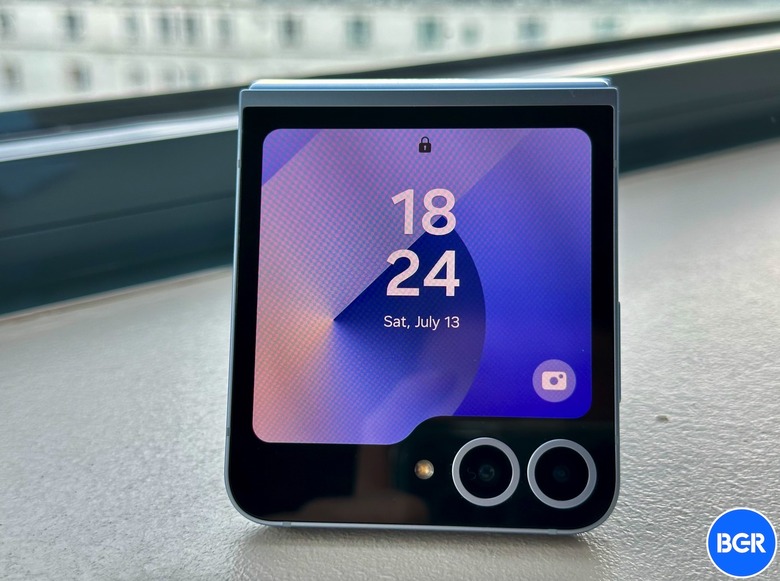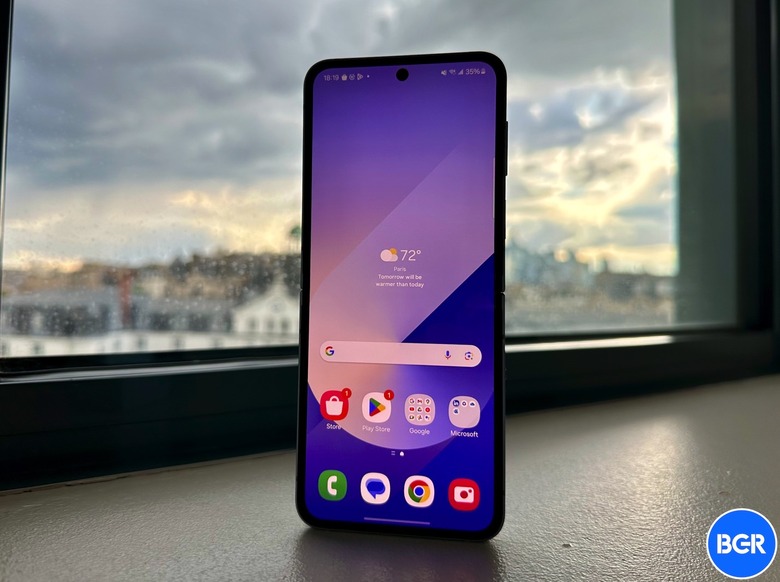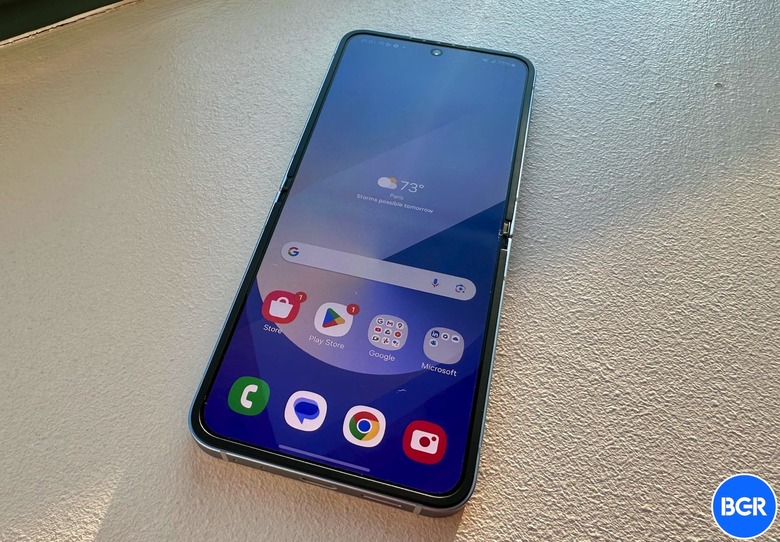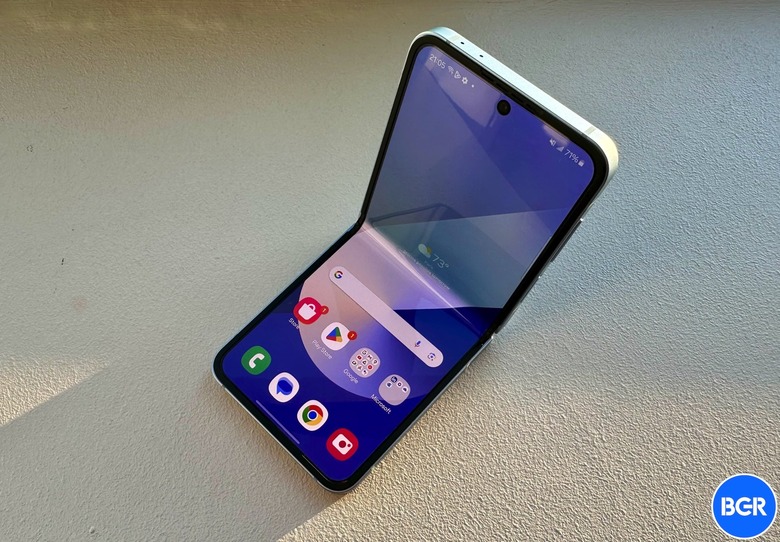Samsung Galaxy Z Flip 6 Review: Flipping A True Flagship
- Improved durability
- Big specs upgrade
- Larger battery
- Upgraded camera
- Galaxy AI
- Price
| Buy From | List Price | Sale Price | |
|---|---|---|---|
| Amazon | $1,099 | See It |
This year, Samsung delivered two radically different approaches with the Galaxy Z Fold 6 and Galaxy Z Flip 6. The new Fold is the foldable that brings the biggest design changes compared to its predecessor, while the specs upgrade is more muted. The new Flip packs the same design as the previous version, but the specs upgrade is where the Galaxy Z Flip 6 really shines.
After my hands-on preview from Paris, France, I said the Galaxy Z Flip 6 is basically a Galaxy S24 that can fold in half. After spending over a week with the handset, I'm convinced that's the case. The newest Galaxy Z Flip is finally on par with the Galaxy S, which is something I always thought Samsung should have done with the Flip series.
Yes, the Galaxy Z Flip 6 costs $100 more than its predecessor, but the difference is worth it for much better specs in an even sturdier body. The camera also got a big upgrade — finally — making this a true foldable flagship phone.
Samsung Galaxy Z Flip 6 specs
| Dimensions | 85.1 x 71.9 x 14.9 mm (folded) |
| IP rating | IP48 |
| Display resolution | Exterior: 720 x 748 Interior: 1080 x 2640 |
| Display size | Exterior: 3.4 inches Interior: 6.7 inches |
| Display type | LTPO AMOLED |
| Display refresh rate | 120Hz |
| Display brightness | 2600 nits (peak) |
| Chipset | Qualcomm Snapdragon 8 Gen 3 |
| Memory | 12GB |
| Storage | 256GB, 512GB |
| Rear cameras | Wide: 50MP, f/1.8 Ultrawide: 12MP, f/2.2, 123-degrees |
| Video | 4K at 60fps |
| Front cameras | 10MP, f/2.2 |
| Ports | USB-C |
| Battery size | 4,000mAh |
| Charging | 25W wired, 15W wireless, 4.5W reverse wireless |
| Connectivity | Bluetooth 5.3, Wi-Fi 6e, 5G |
| Colors | Silver Shadow, Yellow, Blue, Mint, Crafted Black, White, Peach |
| Price | $1,099.99 |
Samsung Galaxy Z Flip 6 design
If you've followed the rumors, you knew Samsung would not deliver a groundbreaking design change with the Galaxy Z Flip 6. The Flip 6 is almost a carbon copy of the Flip 5, and that's not necessarily bad, considering the specs upgrade.
Also, as a longtime iPhone owner I'm used to new phones looking almost exactly like last year's generation, save for a few details. Because yes, the Flip 6 has a few design tweaks that give it a distinct personality.
The Flip 6 might be just as tall, wide, and (almost as) thick as its predecessor, featuring the same rounded corners and flat edges. But the glossy metal is replaced by a matte option that I prefer over the Flip 5. Also, the rear-facing panel is matte instead of shiny, which makes it look and feel better.
When folded, the phone is 0.2mm thinner than the Flip 5, but you won't notice that.
The camera rings get a color accent that matches the rear panel. That's the fastest way to tell you're looking at the brand-new Galaxy Z Flip 6 rather than its predecessor. Yes, the blue version looks great in real life, though I was also partial to the yellow option.
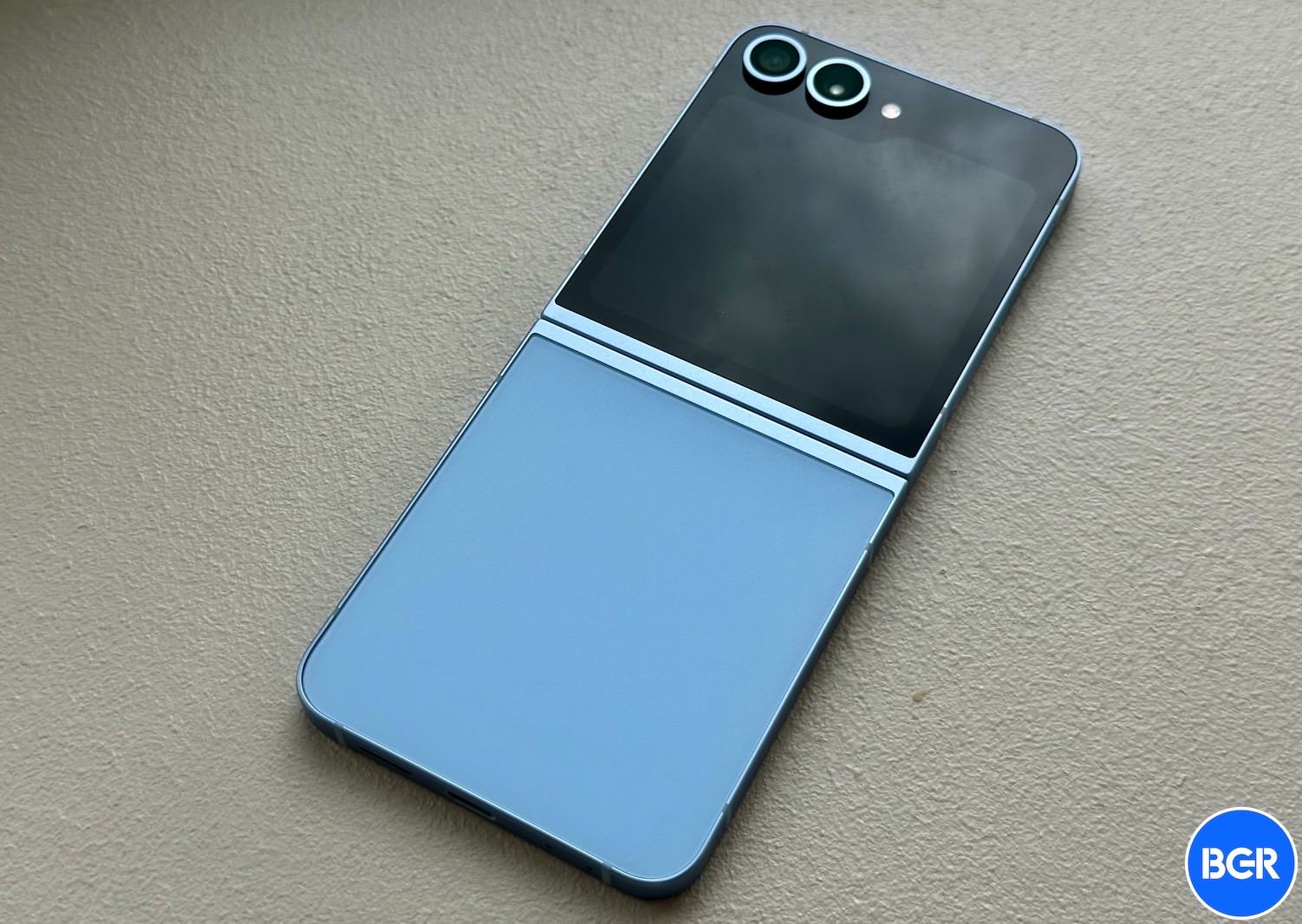
While the design upgrades are minimal, Samsung improved the durability of both 2024 foldables. Like the larger Fold, the Flip 6 now gets dust protection in addition to water resistance. The rating has gone up to IP48 this year from last year's IPX8. Still, remember the foldable screen isn't as durable as a traditional display, so you'll want to handle it carefully.
On that note, the display features thicker foldable glass that's supposed to be more durable. There's also a new, slimmer hinge under the screen. Combined with the display, it should make the crease a little less visible. But in practice, that's not the case. I only needed a minute with the Galaxy Z Flip 6 to see and feel the crease. But you get used to it very quickly.
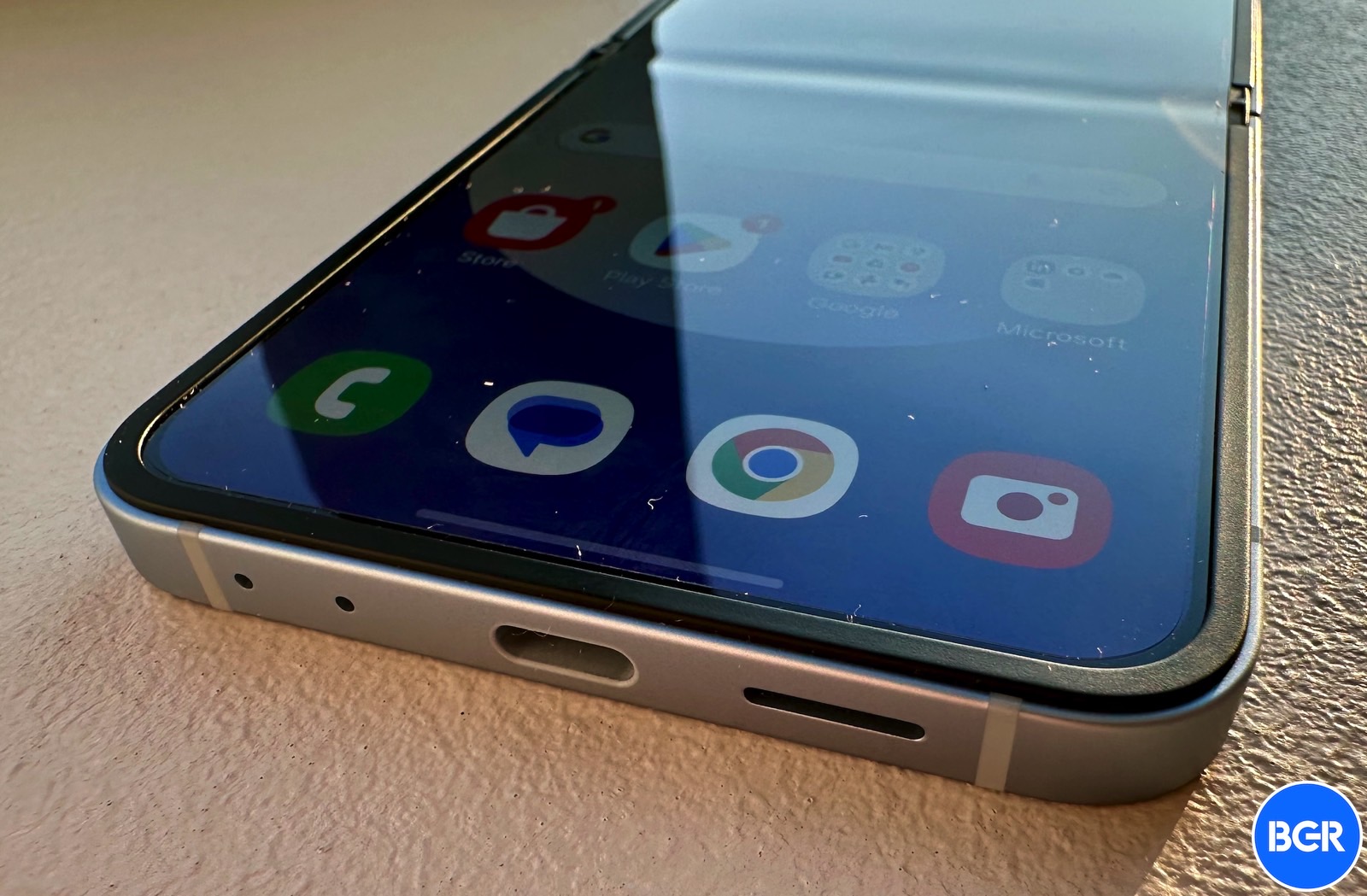
Other durability features concern the Armor Aluminum frame, which is now "enhanced," and the Corning Gorilla Glass Victus 2 panel that covers the external display and rear panel.
I'll note that I haven't used any protective equipment with the handset — well, other than the preinstalled film that comes with the screen, which you shouldn't remove. I've had no problem carrying the Flip 6 in my pocket, and it's a nice change from a traditional candy bar phone. But I did avoid placing it in the same pocket with keys or coins while touring Paris to prevent scratches on the aluminum case.
I'll also point out that some dust or pocket lint will get between the two sides of the foldable screen, even though the Flip 6 folds perfectly flush. You'll be swiping the screen frequently, but make sure you're gentle about it.
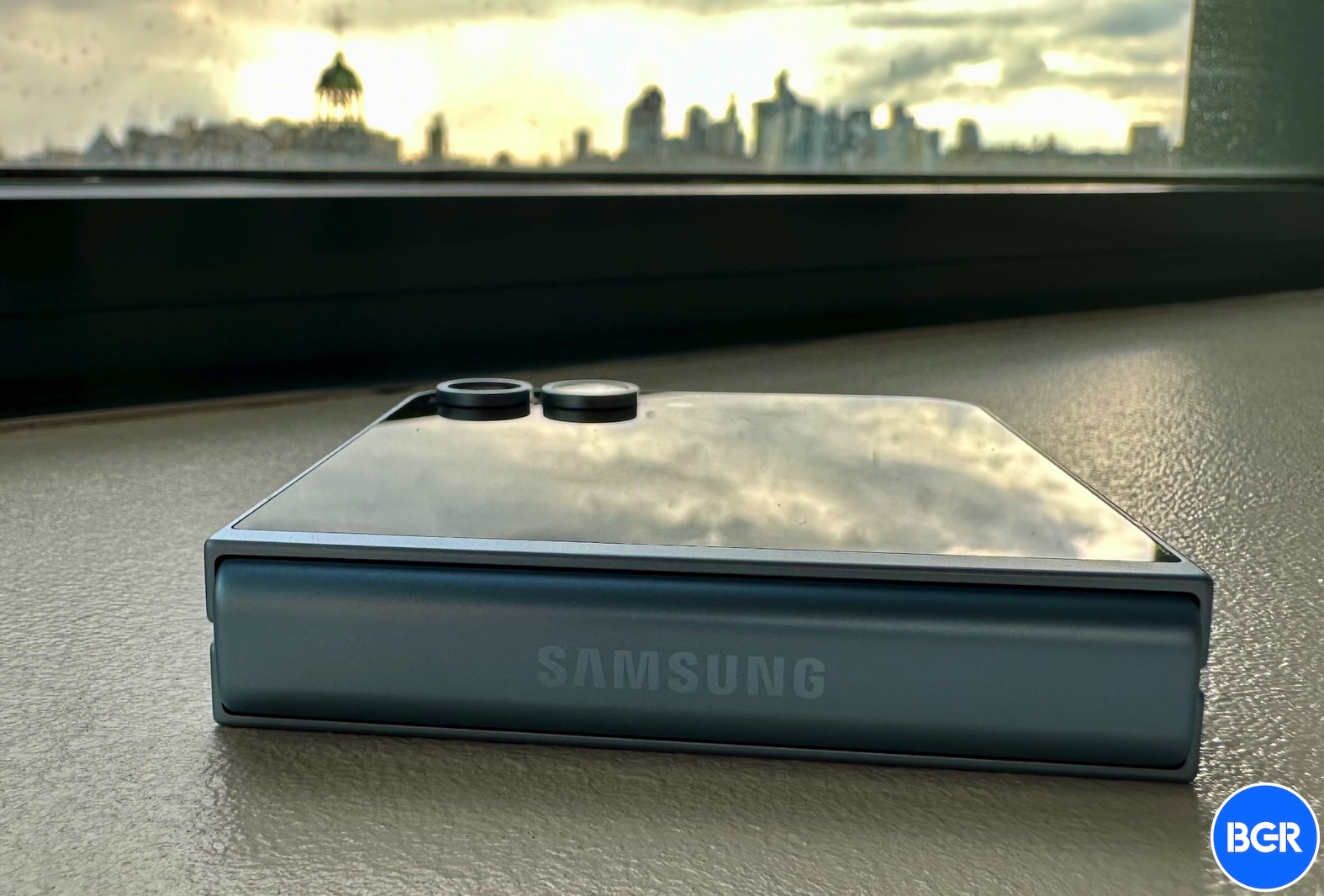
Samsung Galaxy Z Flip 6 display
Like I said before, it's the specs of the Galaxy Z Flip 6 that make it shine. So be prepared to hear, again, how the handset resembles a Galaxy S24, starting with the main screen.
The Galaxy Z Flip 6 features the same familiar 6.7-inch LTPO AMOLED panel as its predecessor. You get the same 2640 x 1080 resolution and adaptive refresh rate (1-120Hz). But, like the Galaxy S24, the peak brightness goes up to 2,600 nits from 1,750 nits on the Flip 5. That translates into a crisp, clear image, even when walking out in the summer sun, something I did more than once while sightseeing through Paris and capturing all the photos I could get with the Flip 6's main camera.
One complaint you'd hear about this type of flagship display is the resolution. But I think Full HD is perfect for these handsets. Anything over that would be overkill and a strain on the battery. On the same note, I'd be ready to sacrifice the 120Hz refresh rate for better battery life. Thankfully, I never felt I had to.
If the foldable screen marks a big upgrade, the external 3.4-inch Super AMOLED screen is nothing to write home about. It's the same panel Samsung used for the Flip 5: a 3.4-inch AMOLED screen with 720 x 748 resolution. But you don't really need better for a cover screen you won't use that much. Yes, the screen supports widgets of all sorts and interactive displays. But it doesn't run full apps as some competitors do.
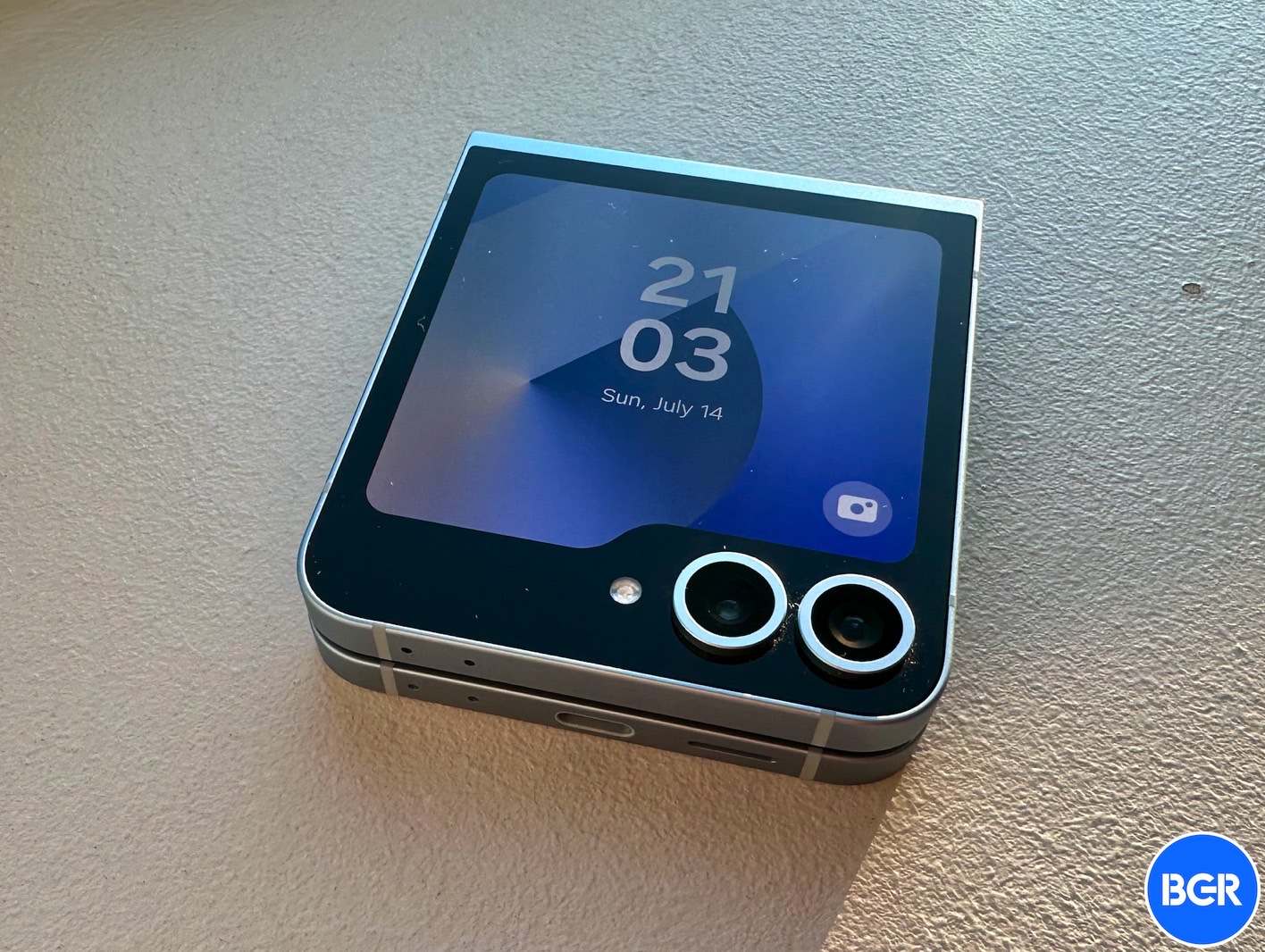
The real usefulness of the screen concerns selfies. That's what I used it the most for, as a viewfinder for the main camera sensor. It also comes with an Auto Zoom feature where the AI will try to fit everyone in the photo, but one I couldn't really get to trigger with the crowds in front of the Mona Lisa painting at the Louvre or all the statues I made friends with.
Samsung Galaxy Z Flip 6 performance
When it comes to processing power, the Galaxy Z Flip 6 matches the Fold 6 and Galaxy S24 phones with its exclusive Qualcomm Snapdragon 8 Gen 3 "for Galaxy" chip. More interestingly, the foldable comes with 12GB of RAM and at least 256GB of storage — better than the base Galaxy S24 configuration. The extra RAM will come in handy for all the current and future Galaxy AI features that ship with the Android 14 operating system.
The Flip 6 is also the first of its kind to feature a vapor chamber, and it might need one. I found the handset getting slightly warm more than once during longer photo sessions. It didn't happen during normal use or while streaming video continuously.
I'll say that the weather has been anything but great while I was in Paris. That's better than the summer heat while visiting a city as beautiful as the French capital. But what I'm getting at is that environmental temperatures have not been the reason why the Flip 6 got warm to the touch.
Speaking of getting hot, the Flip 6 also got warm during benchmark tests. The same happened during a short gaming session without game booster enabled or rich ray-tracing graphics. Surprisingly, it sometimes scored lower in GeekBench 6 tests than the Fold 6, and I wonder whether the processor was throttled there. The scores were as low as 1,400 in some instances. Here are the best scores, however:
- Geekbench 6: 2,242 single-core, 6,761 multi-core
- 3DMark Wild Life Extreme: 4641
Don't be fooled, however. The phone is incredibly fast. It handles anything you throw at it very well, and you can switch back and forth between apps with ease. Galaxy AI features are also remarkably fast, though not everything is processed locally. Most Galaxy AI features you'll want to use are beamed to the cloud.
Samsung Galaxy Z Flip 6 battery and charging
Another big Galaxy Z Flip 6 specs upgrade concerns the battery. The foldable features a 4,000 mAh dual-pack battery instead of its predecessor's 3,700 mAh unit. Since battery life is one aspect that people criticized about the previous Flip model, the 300 mAh bump is definitely welcome.
Remember that the phone also gets the more efficient Snapdragon 8 Gen 3 chip that should improve battery life.
However, you're still stuck with a 25W USB-C wired charging. But that's enough to give you a 50% charge in around 30 minutes. In practice, I found no issue with the charging speed, but that's because that's my usual speed for the iPhone.
Wireless charging will top at 15W, and the Flip 6 supports reverse wireless charging. This will be useful if your Galaxy Buds 3 earbuds run out of juice.
As for actual battery consumption, the Galaxy Z Flip 6 will easily last more than a day during normal operation. However, you might want to recharge it overnight or top it off in the morning.
I did run a video playback test for the handset. I had the Galaxy Z Flip 6 stream video continuously over a Wi-Fi connection, with the volume and screen brightness set at 50%. The phone lasted about 16:30 hours, which is lower than Samsung's 23-hour estimate. Samsung ran its video test with 720p video stored on the handset while I streamed content at a Full HD resolution over Wi-Fi.
Still, that's great battery life, if you ask me, and I think my battery anxiety wouldn't kick in that often considering what I do on phones most of the time: browsing the web, social media, video consumption, and the rare game to kill time.
Samsung Galaxy Z Flip 6 camera
The camera is probably the Galaxy S24-type upgrade Flip 6 buyers will appreciate the most. Samsung has finally fixed the main issue with previous Flip models. Their cameras did not rock the best possible cameras Samsung could use for flagship models. The Flips did not get the same cameras as their Galaxy S equivalent, which is a shame.
The Flip 6 features two cameras on the back, and both match their equivalents on the Galaxy S24. The wide camera has a 50-megapixel lens with F1.8 aperture, optical image stabilization, and 2x zoom. The ultra-wide camera features a 12-megapixel 123-degree sensor with F2.2 aperture.
The hole-punch camera that pierces the Infinity Flex Display gets a 10-megapixel sensor with F2.2. Ok, the selfie camera isn't on par with the Galaxy S24. But I think one should take most selfies using the main module, with the cover screen acting as a viewfinder. That's what I did, and what I'll keep doing whenever I have to snap a selfie using a clamshell foldables.
What does that mean in practice? Well, as you can see in this post, I took a boatload of photos while touring Paris. I just pointed and shot the camera without editing the images or videos. I used all sorts of lighting conditions, both natural and indoors. I zoomed in and out and went for ultra-wide-angle shots where appropriate.
You must know that the Galaxy Z Flip 6's 50-megapixel lens defaults to 12-megapixel photos, similar to the iPhone's 48-megapixel main camera. If you want 50-megapixel images, you'll have to remember to select the resolution beforehand.
After capturing a few hundred photos and a few videos, I think the Galaxy Z Flip 6 is a dependable camera that will come in handy day in and day out. There's lots of detail in the images, and the colors look true to life. What you see is what you capture. There's no tint here that makes the photos unnatural, though, again, I did not use any edits.
I would normally advise against going over 2x zoom, and that's with the wide lens set to 12-megapixel photos. You will lose quality as you go higher. But you can go up to 10x if you really need to zoom here, and the quality of zoomed pics between 2x and 10x isn't bad, especially in good lighting conditions. When shooting 50-megapixel photos, zoom options will range between 1x and 5x.
The Galaxy Z Flip 6 does well in low-light environments, and I've just realized I never even thought about using a flash – not even to test it out. But as the night sets in, you'll need lots of light to get great photos. Thankfully, if you're taking a boat tour at night near the Eiffel Tower, this iconic landmark will provide all the light you need.
I also have to mention the good news about moon shots. Samsung's AI no longer fakes them. Or if it does, I couldn't replicate it, which is a win in my book.
On the video front, expect more grainy results in low-lit environments. Otherwise, you should get good-looking clips with great audio. If you need to capture both points of view, you can record simultaneously with the front and rear cameras. Also, Galaxy AI lets you turn any clip into a Slow-Motion video and then save the slow-motion version.
Holding the Galaxy Z Flip 6 folded at a 90-degree angle like a camcorder from the last century is a fun way to record video. I used it several times, but it's just a gimmick. However, you might want to fold that screen when taking photos of the sky, like me trying to capture some of the Bastille Day planes parading above Paris. It also comes in handy while trying to take pictures of the amazing ceilings of the massive Louvre Museum.
Galaxy AI is also available for editing photos, of course. Generative AI can remove objects from the image and fill in the contents appropriately. Galaxy AI on the Flip 6 will also let you draw objects into photos (Sketch to Image) and turn your selfie into various types of sketches that look impressive (that's the Portrait Studio feature).
The ProVisual Engine is in charge of capturing content and powering the Galaxy AI edits on the phone.
Samsung Galaxy Z Flip 6 software
Google's Android 14 runs the whole show here, with Samsung's One UI 6.1.1 on top. The Android 15 update is imminent, at least for Pixel devices, but it's unclear how long it'll take Samsung to deploy it.
That said, the software runs well, and the hardware makes everything feel fast and snappy. Apps load fast and run well, and taking photos is lag-free. I never felt like the phone was stopping to process images or videos. I just pressed the screen or volume down button to capture a quick series of photographs without worrying I would be able to capture the moment.
The only time the phone had to pause and process things was when I played with the Galaxy AI features. Some of that data gets sent to the cloud and back, but that ProVisual Engine is quite fast, and I never had to wait too long. You can perform some of those genAI edits on the spot right after taking your photos.
The Galaxy Z Flip 6 unit Samsung provided comes with 512GB of storage, which means I never had to worry about storage. I installed all the apps I needed and snapped lots of content without worrying about it. During preorders, you can upgrade the storage for free, though the 256GB of space should be more than enough.
I mention storage here because Samsung packs all sorts of apps on the phone. You might not need some of them, so you'll want to delete them.
The real highlight of the Galaxy Z Flip 6 (and Fold 6) is the Galaxy AI functionality built into the software. Some of it will feel familiar, as it's similar to the genAI features introduced in early January with the Galaxy S24 phones.
Circle to Search is easily a highlight, one that works on the foldable display. Just invoke the Google Assistant and then use Circle to Search. But Samsung has added a few features and improved existing ones in addition to the ones I mentioned in the camera section above.
For example, Live Translate will work with additional languages and support third-party apps like WhatsApp. Note Assist, which already offers translation and summaries, will now support transcription and translation. PDF files also get the translation feature, with the text overlaying the original.
Best of all, the Interpreter now uses the foldable display to show each participant in a live conversation the translated words in their language. It sounds better than it works, however.
I tested the feature while waiting to get into the Louvre, where everyone speaks English, of course. The Interpreter was quick to transcribe spoken content on both the foldable display facing me and the external screen, but it wasn't perfect. It missed parts of the conversation or picked up surrounding noise. Still, this is a step in the right direction. It worked a lot better at home, translating YouTube videos in real time.
Galaxy AI will also benefit from the Gemini assistant that Google unveiled at I/O 2024. That multimodal assistant experience isn't ready now. But you get access to Gemini on the handset, including Gemini support in other Google apps.
Back to regular, non-AI software, the Flip 6 isn't as good for multitasking as the Fold 6, however. You don't have as large a canvas to work with, so it's not that fun using multiple apps side-by-side. You can do it easily, but I never felt I needed such an experience.
The Flip has a tall display when unfolded, giving you access to extra content. Focusing on the app at hand and quickly switching between apps is better for me than using two or more apps on the screen simultaneously. The Snapdragon 8 Gen 3 chip certainly makes everything run fast and smooth.
The only time I used multiple apps simultaneously was during the Bastille Day festivities. After walking a futile 5K race around the Arc de Triomphe in hopes of catching the parade, I found myself stuck on side roads with many other Parisians and tourists. This year's parade was more limited in scope because of the Summer Olympic Games that are about to start in the city. Hence, people getting stuck on secondary streets.
Therefore, I watched the parade live on the Galaxy Z Flip 6's bright display on that side street, waiting for some of the cavalry groups to use the street to exit the venue. Then, I waited for the plane to fly by.
But I preferred to move between the streaming app and the camera to capture content, with video playing in picture-in-picture mode. The chip made switching back and forth between apps a breeze. I could have run up to three apps at the same time, however. Two would run in split-screen, with a third hovering on top of them.
Also, if you fold the screen halfway through, you'll get a Flex mode, where the bottom side of the screen will offer additional controls. That could come in handy for some apps. This mode lets you capture photos and videos with the internal selfie cam while the Galaxy Z Flip 6 sits flat.
Finally, I'll remind you that phones like the Galaxy S24 and the Flip 6 are guaranteed to receive 7 years of Android software updates and 7 years of security updates. I just don't think the Flip 6's foldable screen will survive that long.
Conclusions
With all that in mind, I'll say it over and over: The Galaxy Z Flip 6 is a Galaxy S24 that folds in half. It offers great performance, exciting Galaxy AI features, better battery life, and significant camera improvements.
This is, without a doubt, the best Flip model you can buy right now. Sure, that's what you'd expect from the latest model in a series, but that's truer than ever this year. Samsung is still playing it safe here, choosing not to deliver big Flip design changes and focus on the big specs bump and the software experience. But Samsung can still afford to do that.
More annoyingly, Samsung also feels it can raise the price of the Flip 6. The clamshell costs $100 more in the US, while international price variations might vary. That said, the Galaxy Z Flip 6 could be a great purchase this year if you're a fan of foldables. Again, you're practically buying a Galaxy S24 variant, though you have to pay a little extra for it.
I'd normally advise against upgrading from last year's model when looking at a new release. But I think you should consider replacing the Flip 5 with the Flip 6. After all, preorder deals will get you plenty of credit for turning in last year's model in favor of the Flip 6.
Also, the new Flip is a no-brainer if you own anything older than the Flip 4. Again, all of this applies if you have the budget for a foldable.
The competition
Samsung can afford to raise the price of the Flip 6 because there's not a lot of competition in this department. For most people, the only real option is the Motorola Razr. Moto launched two Razr models in the days preceding Samsung's launch event in Paris.
The Razr Plus is the flagship of the two, featuring a larger cover display, one that can run full apps without any trickery involved. The Plus rocks a slightly worse Snapdragon 8s Gen 3 chip, but it does feature a few upgrades over the Galaxy Z Flip 6. That's faster 45W charging for the battery and a 32-megapixel camera.
I'll also note that Xiaomi will launch a Mix Flip foldable by the time this Galaxy Z Flip 6 review comes out. However, that clamshell will not be available in the US.
Should you buy the Samsung Galaxy Z Flip 6?
As you've probably realized from reading the conclusion section, the answer is yes. You should get a Galaxy Z Flip 6 if you're a fan of foldables and the budget allows it, especially if you can take advantage of the preorder deals. The Flip 6 is a true Android flagship complete with Galaxy AI features.
I say that as a longtime iPhone user who is a little jealous of the Galaxy Z Flip 6. That's something that hasn't happened in the past with other Samsung clamshells. With a few key changes, I would love a clamshell iPhone to replace the current candy bar option. I'd get a Pro Max experience from an iPhone that folds into a tight package. But that's a topic for a different day.
